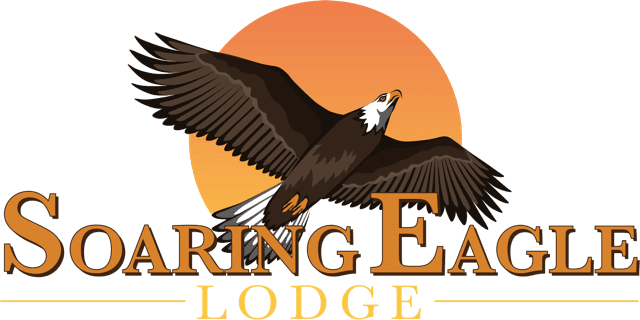Safety Tips
Alaska Safety Tips
You will be spending a week or longer in Alaska with Soaring Eagle Lodge. Much of what you will be doing during the week features exposure to a level of outdoor activity most people are not accustomed to in their daily lives. Whether the activity is a saltwater fishing trip, kayaking, flight-seeing, remote fly out fishing or even a car trip into town you will probably encounter conditions requiring a little forewarning and a little thought in the process. We will be reviewing the following list of things to be mindful of during your welcoming briefing. We will leave a copy with you and keep a copy in your guest file indicating that we have had a chance to explain some the do’s and don’ts while you enjoy your visit in Alaska.
Traffic Safety Tips
Traffic rules are much the same as at your home but when in doubt ask and be careful. This includes conduct with school buses, turns on red, posted speed limits. Emergencies should be reported by dialing 911 — same as most other places. The local area is serviced by a volunteer fire department, which has an EMS capability. The non-city areas of Alaska are patrolled by the Alaska State Troopers a very well staffed, trained and helpful organization should you encounter them during your visit.
State Trooper Information
You may encounter State Park Rangers and Fish & Wildlife Enforcement Officers who are also State Troopers. All of these individuals and organizations are charged with local area law enforcement and fish and game rule enforcement. We will explain fishing regulations to you at your welcome orientation in that they change during the course of the summer and from river to river etc…
“Bluff” Safety Tips
Your cottage is located on a “bluff” which faces west and the Alaska Mountain Range and Cook Inlet. The “bluff” on the property or any “bluff” in the area is a special safety concern. Never approach the “bluff” closer than at least ten feet. Stay back and stay safe. There is nothing to gain by moving closer and much to lose. The edge of any “bluff” is subject to erosion and caution is important. Many of the side or secondary roads in the area are a combination of dirt and gravel and pose several safety concerns that you may not encounter in your normal life. Be especially careful of oncoming traffic, which often crowds the centerline. Stay at or below the speed limit to insure you have full control of your automobile and to avoid slides while cornering. These secondary roads are often home territory to wildlife, especially moose and require reduced speeds and special attention to avoid crossing and darting animals. Alaskan wildlife is a special highlight to most visitors. Moose, bears and eagles pose a serious safety concern for a number of reasons.
Bear Safety Tips
You will most probably NOT encounter a bear anywhere near your cottage. It would be extremely unlikely. It’s always best to make a good deal of noise when walking in more remote areas — bears don’t really want to see you either. Other likely bear encounters are more likely to take place on a fly out fishing or adventure flight. In these cases, your host/guide will provide information and caution for those specific situations. Avoid bears. Move away from bears and remain with your guide.
Moose Safety Tips
Moose encounters are frequent and early in the summer season moose are on the cottage property both early and late in the day. Moose are very often encountered along the roadways where they can be found grazing in the adjacent areas. They will dart onto the road so it’s extremely important to keep a watchful eye out for these very large animals. Never approach a moose, much less a moose with newborn calves. They like all moms are extremely protective and approximately six times larger and faster than you. They won’t eat you but they will kick, stomp, shove and cause much harm to your person. So, take your pictures cautiously.
The secondary problem with moose in particular but including all wildlife is the danger encountered when multiple rental cars are stopped on the side of the road to take pictures of wildlife. It is common for cars to stop right in the middle of the highway or to take other actions like crossing the highway without looking at anything but the moose across the road. It is best to avoid this behavior oneself and to guard against being distracted when you encounter these circumstances. It is good to drive defensively.
Boat Safety Tips
Boat safety is a very high priority during your visit and we ask that you follow all requests regarding safety on our boats or any boat that you may travel on during your stay. The boat captain is in charge and will familiarize you with boat safety rules. The waters in and around Cook Inlet are potentially dangerous unless all necessary caution is employed. This particularly true of local winds and tides. There are times when the boat captain will delay, cancel or cut short a boat or fishing trip due to circumstances. His word is final. We do not allow hard liquor or glass on board. You may bring beer for those who are of age.
Tide Safety Tips
Tides in the vicinity are some of the most severe in the country with tide exchanges of up to 28 feet not uncommon. This fact is very important to beach use especially to those digging clams. Each year emergencies occur when a visitor forgets to pay attention and becomes isolated on a stretch of beach and surrounded by quickly rising , incoming tides. Of less concern but still very important are automobiles left on a beach below the high tide line that are swept away each summer as a new tide rushes onto the area beaches.
